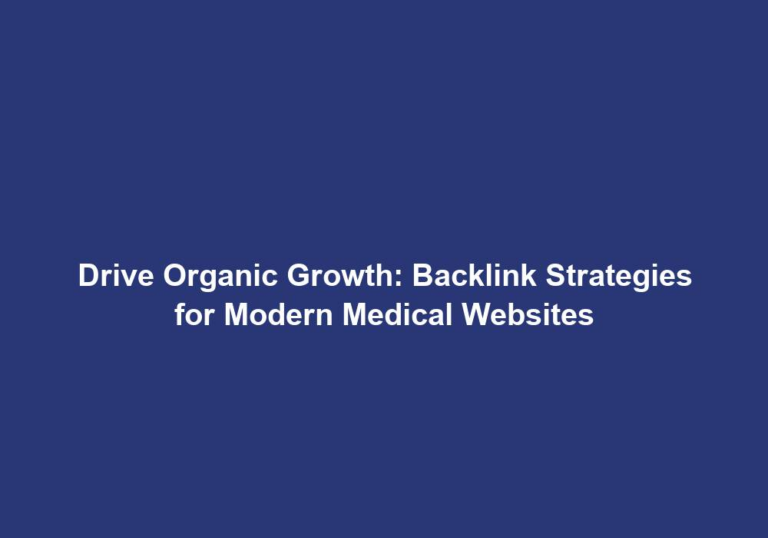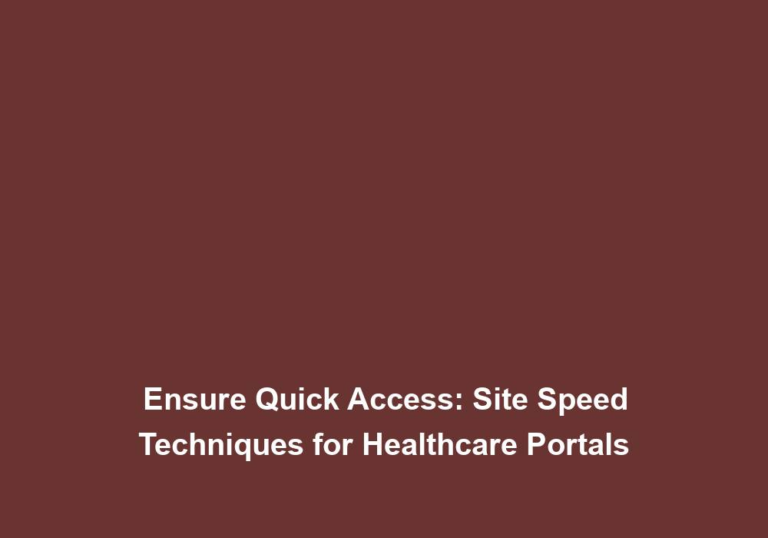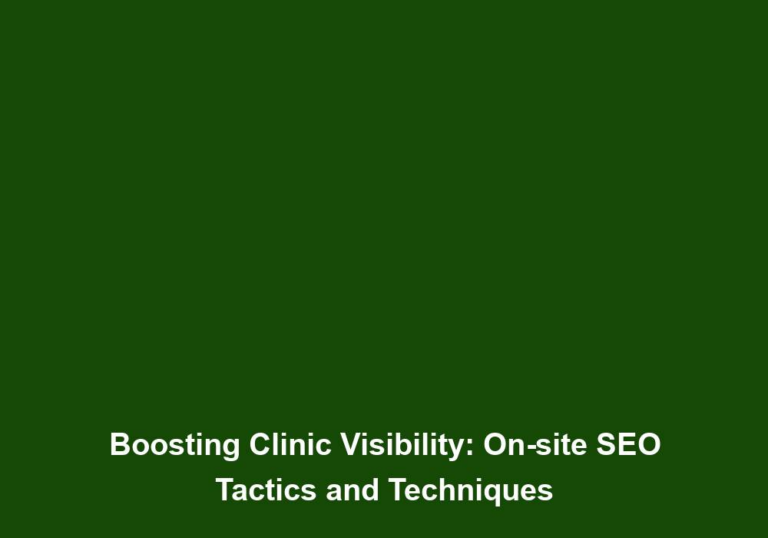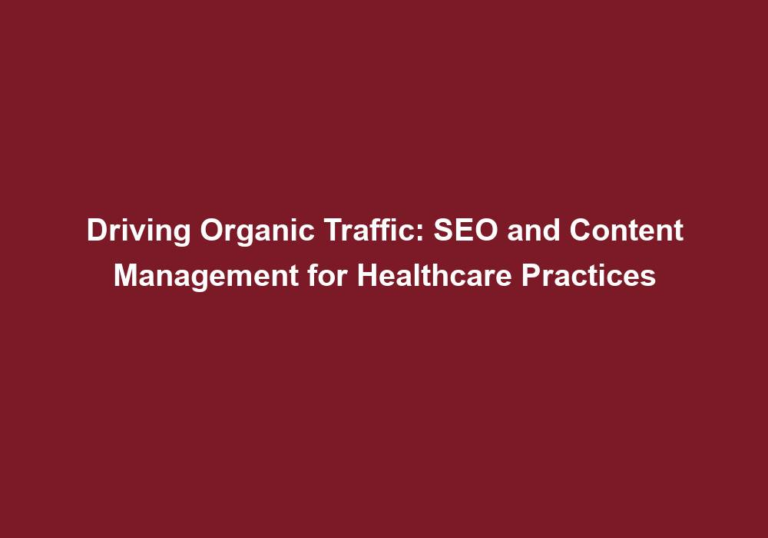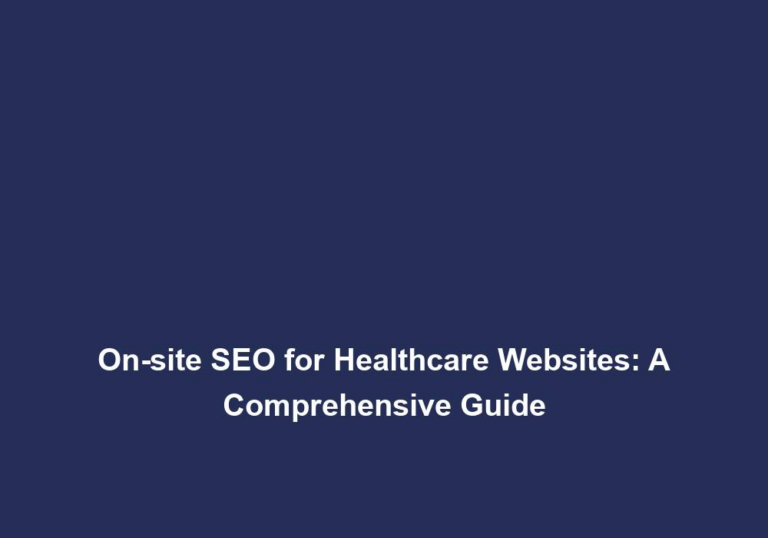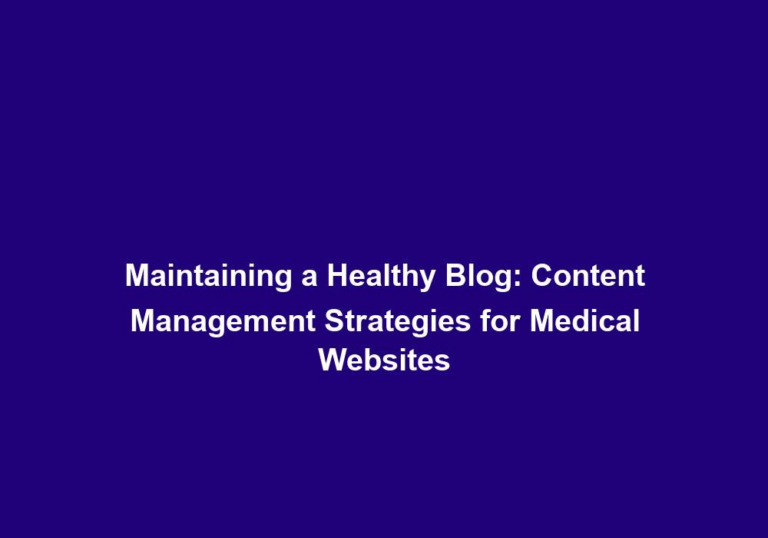Optimizing Healthcare Websites: On-site SEO Best Practices
In today’s digital era, having a well-optimized website is crucial for the success of any business, including healthcare providers. With millions of people turning to the internet for medical information and services, it is essential for healthcare websites to rank high in search engine results. This can be achieved through effective on-site SEO (Search Engine Optimization) strategies. In this article, we will explore the best practices for optimizing healthcare websites to improve their visibility and attract more patients.
1. Conduct Thorough Keyword Research
Keyword research forms the foundation of any successful SEO strategy. Start by identifying the keywords and phrases that potential patients are likely to use when searching for healthcare services. Consider using tools like Google Keyword Planner or SEMrush to discover relevant keywords. Additionally, analyze the keywords your competitors are ranking for to gain a competitive advantage.
To conduct thorough keyword research, follow these steps:
- Begin by brainstorming a list of terms and phrases that are relevant to your healthcare services.
- Use keyword research tools like Google Keyword Planner or SEMrush to expand your list and discover additional keywords that are popular among search engine users.
- Analyze the search volume and competition for each keyword to determine its potential value.
- Prioritize keywords that have high search volume and low competition to maximize your chances of ranking well in search results.
- Consider long-tail keywords, which are longer and more specific phrases, as they tend to have less competition and can attract highly targeted traffic.
By conducting thorough keyword research, you can optimize your healthcare website to target the most relevant and high-value keywords, increasing its visibility in search engine results.
2. Optimize Metadata
Metadata plays a significant role in improving a website’s visibility in search engine results pages (SERPs). Ensure that your healthcare website’s metadata is well-optimized for search engines by following these guidelines:
-
Title Tags: Craft unique and descriptive title tags for each page of your website. Include relevant keywords and keep the title under 60 characters to ensure it appears fully in search results. For example, instead of simply using “Services” as a title tag, consider using “Comprehensive Healthcare Services in [Your Location]” to provide more information and improve search visibility.
-
Meta Descriptions: Write compelling meta descriptions that summarize the content of each page. Include relevant keywords and maintain a length of around 160 characters. Use this space to entice search engine users to click on your website by highlighting the unique value you offer. For instance, a meta description for a page about pediatric services could say, “Get expert pediatric care from our experienced team of doctors. We provide comprehensive services tailored to meet the unique needs of children.”
-
Header Tags: Utilize header tags (H1, H2, H3, etc.) to structure your content effectively. Include target keywords in these tags where appropriate, but make sure the content remains natural and easy to read. Header tags not only help search engines understand the hierarchy and organization of your content but also make it easier for users to navigate through your website. For example, use an H1 tag for the main heading of a page and H2 tags for subheadings that divide the content into sections.
By optimizing your healthcare website’s metadata, you can improve its visibility in search results and attract more organic traffic from potential patients.
3. Create High-Quality and Relevant Content
Search engines value high-quality, informative, and relevant content. To optimize your healthcare website, focus on:
-
Originality: Ensure that your content is unique and not duplicated from other sources. Search engines penalize websites with duplicate content. Create original content that provides valuable insights, answers common medical questions, and educates visitors about healthcare topics. This positions your website as a reliable resource, improving its chances of ranking higher in search results.
-
Value: Aim to provide valuable information and resources to your target audience. Identify the pain points and concerns of your potential patients and address them through your content. This helps establish your expertise and builds trust with your audience. Consider creating comprehensive guides, blog posts, and articles that go beyond surface-level information and offer in-depth insights.
-
Long-form Content: Aim to create in-depth articles, blog posts, and guides that exceed 900 words. Such content tends to perform better in search rankings as it provides more detailed information and covers a topic more comprehensively. Break your content into sections using subheadings (H2 and H3 tags) to improve readability and make it easier for search engines to understand the structure of your content.
-
Keyword Optimization: Integrate relevant keywords naturally throughout your content. Avoid keyword stuffing, as it can harm your website’s visibility. Use keywords in the title, headings, and body of your content, but ensure they flow naturally and don’t disrupt the readability of your text. Consider using variations of your target keywords to capture a wider range of search queries.
By creating high-quality and relevant content, you can attract and engage your target audience, increase your website’s visibility in search results, and position yourself as a trusted source of healthcare information.
4. Optimize Images
Images can significantly enhance the visual appeal of your healthcare website, but they can also impact its load time if not optimized properly. Consider the following best practices for image optimization:
-
File Size: Compress images to reduce their file size without compromising quality. Large image files can slow down your website, negatively affecting user experience and search rankings. Use image compression tools or plugins to optimize your images before uploading them to your website.
-
Alt Text: Provide descriptive alt text for all images on your website. This helps search engines understand the content of the image and improves accessibility for visually impaired users. Use relevant keywords in the alt text, but make sure it accurately describes the image. For example, instead of using generic alt text like “image123.jpg,” use descriptive alt text like “Pediatrician examining a child in our clinic.”
-
File Names: Use descriptive file names for your images that include relevant keywords. This helps search engines identify and index your images correctly. Instead of using generic file names like “IMG1234.jpg,” rename the image file to something descriptive like “pediatric-services.jpg.”
By optimizing your images, you can improve your website’s load time, enhance user experience, and make your content more accessible to both search engines and users.
5. Improve Website Speed and Mobile Responsiveness
Website speed and mobile responsiveness are crucial factors for both user experience and SEO. Follow these tips to optimize your healthcare website:
-
Page Load Time: Minimize the use of large files, such as images and videos, that may slow down your website. Optimize code and enable browser caching to improve load times. Additionally, choose a reliable web hosting provider that offers fast servers and efficient content delivery.
-
Mobile-Friendly Design: Ensure that your website is mobile responsive, meaning it adapts seamlessly to different screen sizes. Mobile-friendliness is a significant ranking factor for search engines. Test your website’s responsiveness using tools like Google’s Mobile-Friendly Test and make necessary adjustments to provide a smooth browsing experience for mobile users.
-
User-Friendly Navigation: Create clear and intuitive navigation menus that make it easy for users to find the information they need. This enhances user experience and reduces bounce rates. Use descriptive menu labels and organize your content logically, ensuring that important pages are easily accessible from the main navigation menu.
By improving your website’s speed and mobile responsiveness, you can provide a better user experience, increase engagement, and boost your search engine rankings.
6. Build High-Quality Backlinks
Backlinks, or incoming links from other websites, play a crucial role in SEO. They signal to search engines that your website is reputable and trustworthy. Here are some strategies to build high-quality backlinks for your healthcare website:
-
Guest Blogging: Write guest posts on reputable healthcare or medical websites. Include a link back to your website within the article or author bio. Guest blogging not only helps you establish your expertise but also allows you to reach a wider audience and attract valuable backlinks.
-
Local Directories: Submit your healthcare website to relevant local directories, such as medical associations, chambers of commerce, or online healthcare directories. These directories often provide a valuable source of backlinks and can help improve your website’s visibility in local search results.
-
Social Media: Promote your content on social media platforms, encouraging others to link back to your website. Engage with your audience, share valuable insights, and participate in relevant discussions to attract attention and generate backlinks. Additionally, consider leveraging social media influencers or partnering with other healthcare professionals to expand your reach and build valuable connections.
By implementing these strategies to build high-quality backlinks, you can strengthen your website’s authority, improve its search engine rankings, and attract more organic traffic.
Implementing these on-site SEO best practices will help your healthcare website rank higher in search engine results, attract more organic traffic, and ultimately increase the number of patients you serve. Remember to monitor your website’s performance regularly, adjust your strategies as needed, and stay updated with the latest SEO trends to stay ahead of the competition.


